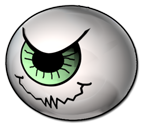Before we launched this web site, I had great hopes for creating new software for the Mac and iPad. Things have not gone as planned.
First, there was a disaster in which both my Mac source code and the backups of that source code were destroyed, along with a lot of our other possessions. Still, I was confident that I could recreate some of the software since most of it involved graphics and animation programming that I’d been doing for my whole career in education and research. I also still had my programming notes, and my wife had not lost the background graphics files she created for these programs. Unfortunately, this proved to not be the limiting factor in my progress.
For the past two decades, I’ve been battling chronic daily migraines. The migraines were at first relatively rare, but with time they increased in both frequency and intensity until they occurred every single day! They eventually worsened to the point where I could barely struggle to get through a work day due to the pain, nausea, dizziness (and falling over every so often), and difficulty concentrating and remembering vital information. Every light and sound caused my head to explode, and focusing on any task was stressful. I could not sleep more than a few hours at night, if that much, or could drop asleep suddenly. I was exhausted most of the time. There were also other sporadic strange symptoms such as being unable to speak some words — I’d have to try to think of a synonym that I could vocalize, which can be difficult with technical terms — that seemed to strike a lot when I was lecturing.
At that point, and since then, I’ve seen several neurologists — many of them migraine specialists — and they’ve been unable to find any treatment that works for me, including all classes of available migraine drugs and some non-conventional treatments. There’s just not enough medical research on migraines and migraine therapy, maybe because people see it as just being a “headache” or maybe because they mostly see it as a disease that strikes women. All that’s left for now is an untested experimental surgery that would be painful, risky and not covered by medical insurance (needless to say, I’m not eager to do it).
I wish that I could say that people other than my wife and some co-workers were empathetic, but they were not. This added to the stress. I eventually was asked by my wife and doctor to stop full-time work. I resisted as long as I could, but my career came to a crashing halt.
After a few months of recovering, I felt that even if I couldn’t work again full-time, I could start recreating some of my educational software for the Mac App Store. My wife had noticed over the years that even when I could not concentrate on journals or writing lectures, I could still easily read computer science and programming textbooks. Strange, but true. Learning how to code for the iPad would be a new challenge and I’d enjoy it a lot too. Of course, my progress would be slower since some days the migraines would keep me from functioning, but I was confident that gradual progress would still occur.
Chronic migraines don’t like to cooperate with your plans. I grossly overestimated how many “good” migraine days I would have on which my symptoms might be mild enough that I could program. For every “good” day (and there were no days with no symptoms at all), I might have a two or three weeks of having to lock myself in a dark quiet room, sometimes unable to eat for two or three days in a row. The migraines have also kept me from doing any new artwork or playing music.
Life’s not fun with daily migraines, but I’m not going to let them stop me from programming. It might take me a long time, but I will publish some software. So please be patient. I’ll get there eventually.

